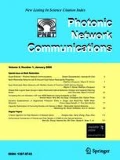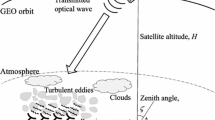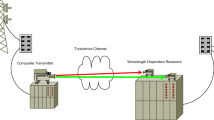Abstract
In this paper, we evaluate the bit error rate (BER) performance of a free-space optical satellite downlink by considering the atmospheric turbulence effects using binary shift keying subcarrier intensity modulation and differential phase shift keying subcarrier intensity modulation (DPSK-SIM). The performance of the link is enhanced using aperture averaging and receiver diversity. The closed form mathematical expressions of BER for BPSK-SIM and DPSK-SIM schemes are derived and analyzed. It is observed that on varying the turbulence level, the performance of the link degrades when the turbulence level increases. The improved BER of 10−12 and 10−10 at signal-to-noise ratio of 30 dB of the link for both BPSK-SIM and DPSK-SIM is obtained by using aperture averaging (aperture diameter, D = 10 cm) and receiver diversity with optimal combining.











Similar content being viewed by others
References
Arnon, S., Uysal, M., Ghassemlooy, Z., Xu, Z., Cheng, J.: Optical wireless communications. IEEE J. Sel. Area. Commun. 33(9), 1733–1737 (2015)
Andrews, L.C., Phillips, R.L.: Laser Beam Propagation Through Random Media, vol. 152. SPIE Press, Bellingham (2005)
Ghassemlooy, Z., Popoola, W.O.: Terrestrial free space optical communications. In: Fares, S.A., Adachi, F. (eds.) Mobile and Wireless Communications Network Layer and Circuit Level Design, pp. 355–391. InTech, Rijeka (2010)
Popoola, W.O., Ghassemlooy, Z.: BPSK subcarrier intensity modulated free-space optical communications in atmospheric turbulence. J. Lightwave Technol. 27(8), 967–973 (2009)
Prabu, K., Sriram Kumar, D.: “BER analysis for BPSK based SIM-FSO communication system over strong atmospheric turbulence with spatial diversity and pointing errors. Wirel. Personal Commun. 81(3), 1143–1157 (2015)
Prabu, K., Sriram Kumar, D.: Performance analysis of free-space optical systems employing binary polarization shift keying signaling over gamma–gamma channel with pointing errors. Opt. Eng. 53(7), 076105 (2014)
Prabu, K., Sriram Kumar, D., Srinivas, T.: Performance analysis of FSO links under strong atmospheric turbulence conditions using various modulation schemes. Optik Int. J. Light Electron Opt. 125(19), 5573–5581 (2014)
Nistazakis, H.E., Tombras, G.S.: On the use of wavelength and time diversity in optical wireless communication systems over gamma–gamma turbulence channels. Opt. Laser Technol. 44(7), 2088–2094 (2012)
Majumdar, A.K.: Advanced Free Space Optics (FSO): A Systems Approach, pp. 69–173. Springer, New York (2015)
Sandalidis, H.G.: Performance of a laser earth-to-satellite link over turbulence and beam wander using the modulated gamma–gamma irradiance distribution. Appl. Opt. 50(6), 952–961 (2011)
Jiang, Y., Tao, K., Song, Y., Fu, S.: Packet error rate analysis of OOK, DPIM and PPM modulation schemes for ground-to-satellite laser uplink communications. Appl. Opt. 53(7), 1268–1273 (2014)
Latinovic, V.: Advanced Optical Communication Systems, pp. 27–40. Clanrye International, New York (2015)
Lee, I.E., Ghassemlooy, Z., Ng, W.P., Uysal, M.: Performance analysis of free space optical links over turbulence and misalignment induced fading channels. In: Proceedings of the 8th IEEE/IET International Symposium on Communication Systems, Networks and Digital Signal Processing (CSNDSP), pp. 1–6 (2012)
Prudnikov, A.P., Brychkov, Y.A., Marichev, O.I.: Integral and Series, Vol. 3: More Special Functions. Gordon and Breach Science Publishers, Amsterdam (1986)
Adamchik, V.S., Marichev, O.I.: The algorithm for calculating integrals of hyper geometric type functions and its realization in REDUCE system. In: Proceedings of International Conference on Symbolic and Algebraic Computation Tokyo, Japan, pp. 212–224 (1990)
Tsiftsis, T.A., Sandalidis, H.G., Karagiannidis, G.K., Uysal, M.: Optical wireless links with spatial diversity over strong atmospheric turbulence channels. IEEE Trans. Wirel. Commun. 8(2), 951–957 (2009)
Chiani, M., Dardari, D., Simon, M.K.: New exponential bounds and approximations for the computation of error probability in fading channels. IEEE Trans. Wirel. Commun. 2(4), 840–845 (2003)
Author information
Authors and Affiliations
Corresponding author
Additional information
Publisher's Note
Springer Nature remains neutral with regard to jurisdictional claims in published maps and institutional affiliations.
Rights and permissions
About this article
Cite this article
Krishnan, P., Jha, G.K. & Walia, A. Performance enhancement of BPSK-SIM- and DPSK-SIM-based FSO downlink over atmospheric turbulence using aperture averaging and receiver diversity. Photon Netw Commun 38, 142–150 (2019). https://doi.org/10.1007/s11107-019-00836-0
Received:
Accepted:
Published:
Issue Date:
DOI: https://doi.org/10.1007/s11107-019-00836-0




